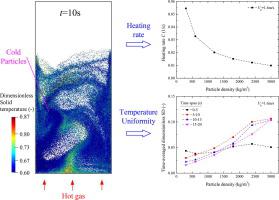Advanced Powder Technology ( IF 5.2 ) Pub Date : 2020-08-28 , DOI: 10.1016/j.apt.2020.08.002 Jiazhe Xue , Liyu Xie , Yingjuan Shao , Wenqi Zhong

|
The solid properties are of significant influence on the thermal performance of the fluidized bed. In order to provide valuable information for the application of this equipment, a numerical study is carried to clarify the effects of solid properties on the heat transfer characteristics in a lab-scale fluidized bed by means of the CFD-DEM method. Specially, two aeration conditions, i.e. the same superficial velocity and the same fluidization number, are considered. The results show that the violent convective mechanism at bed bottom plays a significant role in the heating of the bed material. The entrainment of rising bubbles and hence solid mixing are the key factors to get better temperature uniformity of the bed during the heating process. With the decrease of particle density and size, the internal circulation of solid phase is strengthened under the same superficial velocity, while slightly weakened under the same fluidization number. Obvious resemblance can be captured between solid mixing and temperature uniformity, and the enhanced solid mixing usually leads to homogeneous temperature distribution of the bed. It can be found that the heating rate decreases with increasing solid density regardless of aeration setup. In addition, it is positively related to particle diameter under the same fluidization number, while keep unchanged under the same superficial velocity. Furthermore, enhanced solid mixing and better temperature uniformity can be captured with increasing solid heat capacity, which confirms that gas temperature shows considerable effect on gas-solid flow.
中文翻译:

CFD-DEM研究固体性质和曝气条件对流化床传热的影响
固体性质对流化床的热性能有重大影响。为了为该设备的应用提供有价值的信息,通过CFD-DEM方法进行了数值研究,以澄清固体性质对实验室规模流化床中传热特性的影响。特别地,考虑两个曝气条件,即相同的表观速度和相同的流化数。结果表明,床底的剧烈对流机制在加热床料中起重要作用。夹带上升的气泡并因此进行固体混合是在加热过程中获得更好的床层温度均匀性的关键因素。随着颗粒密度和尺寸的减小,在相同的表观速度下,固相的内循环增强,而在相同的流化数下,固相的内循环略有减弱。可以在固体混合和温度均匀性之间发现明显的相似之处,并且增强的固体混合通常导致床的温度分布均匀。可以发现,无论曝气设置如何,加热速率都随着固体密度的增加而降低。另外,在相同的流化数下,它与粒径成正相关,而在相同的表观速度下,则保持不变。此外,随着固体热容量的增加,可以捕获增强的固体混合和更好的温度均匀性,这证实了气体温度对气固流动显示出显着的影响。在相同的流化数下略有减弱。可以在固体混合和温度均匀性之间发现明显的相似之处,并且增强的固体混合通常导致床的温度分布均匀。可以发现,无论曝气设置如何,加热速率都随着固体密度的增加而降低。另外,在相同的流化数下,它与粒径成正相关,而在相同的表观速度下,则保持不变。此外,随着固体热容量的增加,可以捕获增强的固体混合和更好的温度均匀性,这证实了气体温度对气固流动显示出显着的影响。在相同的流化数下略有减弱。可以在固体混合和温度均匀性之间发现明显的相似之处,并且增强的固体混合通常导致床的温度分布均匀。可以发现,无论曝气设置如何,加热速率都随着固体密度的增加而降低。另外,在相同的流化数下,它与粒径成正相关,而在相同的表观速度下,则保持不变。此外,随着固体热容量的增加,可以捕获增强的固体混合和更好的温度均匀性,这证实了气体温度对气固流动显示出显着的影响。固体混合的增强通常会导致床层温度分布均匀。可以发现,无论曝气设置如何,加热速率都随着固体密度的增加而降低。另外,在相同的流化数下,它与粒径成正相关,而在相同的表观速度下,则保持不变。此外,随着固体热容量的增加,可以捕获增强的固体混合和更好的温度均匀性,这证实了气体温度对气固流动显示出显着的影响。固体混合的增强通常会导致床层温度分布均匀。可以发现,无论曝气设置如何,加热速率都随着固体密度的增加而降低。另外,在相同的流化数下,它与粒径成正相关,而在相同的表观速度下,则保持不变。此外,随着固体热容量的增加,可以捕获增强的固体混合和更好的温度均匀性,这证实了气体温度对气固流动显示出显着的影响。在相同的表观速度下保持不变。此外,随着固体热容量的增加,可以捕获增强的固体混合和更好的温度均匀性,这证实了气体温度对气固流动显示出显着的影响。在相同的表观速度下保持不变。此外,随着固体热容量的增加,可以捕获增强的固体混合和更好的温度均匀性,这证实了气体温度对气固流动显示出显着的影响。



























 京公网安备 11010802027423号
京公网安备 11010802027423号